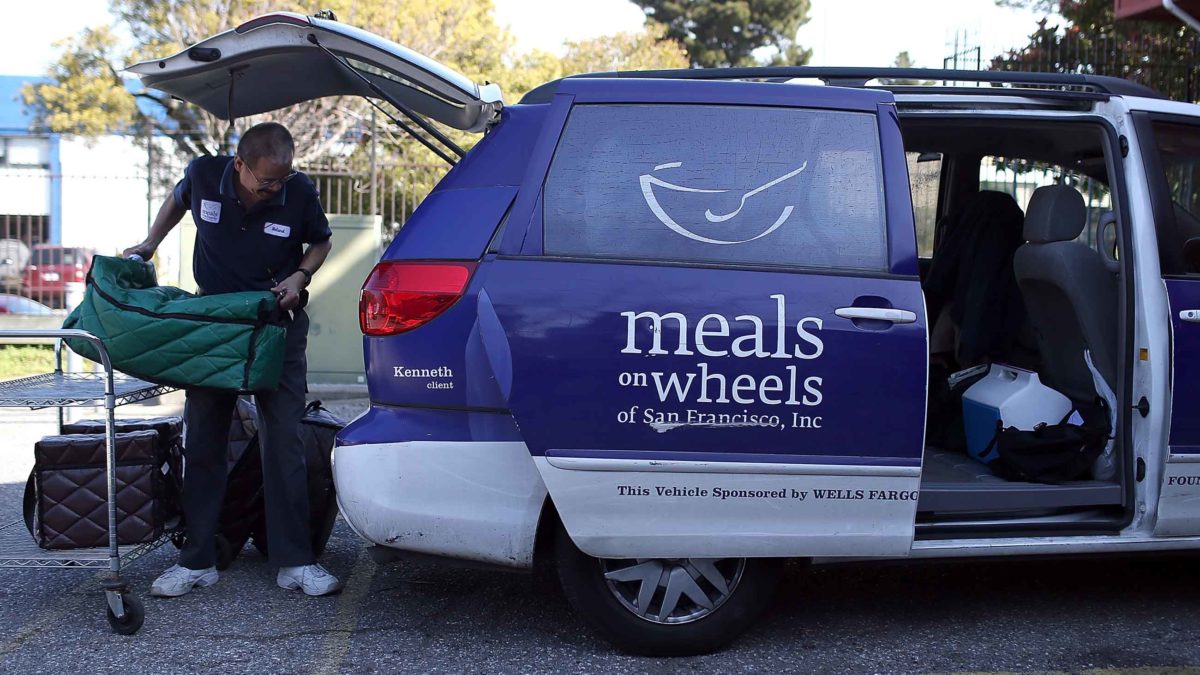Malnutrition in Seniors Underlies Meals on Wheels Debate
One of President Trump’s proposed budget cuts could result in fewer meals for senior citizens, many of whom already suffer from malnutrition.

Threats to funding that support programs like Meals on Wheels have underscored the stunning prevalence of malnutrition among millions of U.S. seniors.
Visual: Justin Sullivan/Getty
Meals on Wheels, an umbrella organization of about 5,000 food assistance-programs nationwide that serve 2.4 million housebound and mostly elderly Americans annually, is not a federal program. Instead, the locally run programs receive a portion of their funding — about a third on average by one measure — from the Community Development Block Grant program. Trump wants to eliminate that budget line as part of an overall 18 percent cut to the Department of Health and Human Services.
Trump’s budget director Mick Mulvaney implied last week that Meals on Wheels is among programs that “don’t work,” a claim that has been discredited in many media reports. Numerous analyses, including a 2013 review of several studies, demonstrate that linking up seniors with home-delivered meals is a low-cost solution to reducing malnutrition, although questions remain about overall outcomes for beneficiaries of these programs.
More than anything, however, the debate over funding has brought the stunning prevalence of malnutrition and lack of access to healthy food — a condition known as food insecurity — among millions of U.S. seniors into clear and sobering focus. The problem is particularly acute among people with low-incomes, depression, and those in rehabilitation facilities or nursing homes.
More than half of a random sample of adults over age 64 at a hospital’s emergency department in the southeastern U.S. were undernourished or at risk for malnutrition, according to a study published last year. A more recent study of 252 older adults visiting three emergency departments in the South, Northeast and Midwest looked at causes of malnutrition. The malnutrition rate in this sample is about 12 percent. Poor and moderate oral health were the biggest risk factors for malnutrition, with food insecurity next.
By the numbers then, malnutrition might be greatly reduced by helping seniors get dental care. Some new programs focus on improving oral health among older Americans, but such care is costly. Medicare mostly doesn’t cover dentistry.
At hospital emergency facilities, health care workers could screen for malnutrition, but typically do not, says study co-author Timothy F. Platts-Mills at the University of North Carolina at Chapel Hill. Factors impeding screening include over-medicalization, insurance reimbursement policies, and the emphasis on testing for conditions requiring urgent treatment.
A malnutrition screen can be performed in as few as three minutes, says Platts-Mills, who specializes in emergency medicine. Hospital staff then could refer seniors who have trouble getting enough food to a local Meals on Wheels or other food assistance program. With an economic burden of about $157 billion annually for malnutrition associated with diseases such as cancer, chronic obstructive pulmonary disease, and depression, according to a 2014 study, the math favors maintaining federal funding that goes to such meal programs, not shrinking it. The cost per person ranges around $6 or $7 per day, or about $2,500 per year, according to various sources.
It would be unfortunate if federal funding for Meals on Wheels effectively were eliminated, says Platts-Mills, in part because lower-income communities lack the funding to make up the difference. “The point would be that some basic social services are likely to be cost-effective,” he says, “and making sure that older adults have access to food is one of those.”
It may shock many Americans to think that our nation has elected leaders who could decide to take food away from grandma and grandpa. But probably not writer and venture capitalist Bruce Cannon Gibney, whose book A Generation of Sociopaths: How the Baby Boomers Betrayed America, came out this month.
In a recent radio interview, Gibney suggested that the largely homogeneous experiences of white, middle-class members of the Boomer Generation — especially those born in the first two-thirds of the period between 1946 and 1964 — have “conditioned them towards less pro-social policies than the prior generation had pursued, and less pro-social policies than their children appear to favor, at least in opinion polls,” Gibney said
Gibney says that the data are not yet in on how the Millennial generation will vote on public spending for social services, including those that feed the elderly, but let’s hope they learned what their grandparents likely taught them: Share and share alike.










